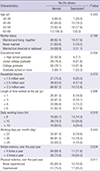1. World Health Organization. Global status report on alcohol and health-2014. Geneva: World Health Organization;2014.
2. Bang HA, Rhim KH, Lee MJ, Lee WC, Kwon YH. A trend of traffic accidents among alcohol-impaired driving in Korea between 2001 and 2009. Korean J Aerosp Environ Med. 2014; 24:32–37.
3. Jung S. Crackdown on drunk driving and due process of law. Transp Technol Policy. 2010; 7:79–84.
4. Gwak HJ, Choi EY. An exploratory study on the quality of job of on-call drivers. Democr Soc Policy Stud. 2015; 27:69–102.
5. Lee HE, Kim HR, Park JS. Work-related risk factors for workplace violence among Korean employees. J Occup Health. 2014; 56:12–20.
6. Park M, Cho SH, Hong HJ. Prevalence and perpetrators of workplace violence by nursing unit and the relationship between violence and the perceived work environment. J Nurs Scholarsh. 2015; 47:87–95.
7. Aytac S, Bozkurt V, Bayram N, Yildiz S, Aytac M, Akinci FS, Bilgel N. Workplace violence: a study of Turkish workers. Int J Occup Saf Ergon. 2011; 17:385–402.
8. Heponiemi T, Kouvonen A, Virtanen M, Vänskä J, Elovainio M. The prospective effects of workplace violence on physicians' job satisfaction and turnover intentions: the buffering effect of job control. BMC Health Serv Res. 2014; 14:19.
9. Kim HC, Min JY, Min KB, Park SG. Job strain and the risk for occupational injury in small- to medium-sized manufacturing enterprises: a prospective study of 1,209 Korean employees. Am J Ind Med. 2009; 52:322–330.
10. Zich JM, Attkisson CC, Greenfield TK. Screening for depression in primary care clinics: the CES-D and the BDI. Int J Psychiatry Med. 1990; 20:259–277.
11. Radloff LS. The CES-D scale a self-report depression scale for research in the general population. Appl Psychol Meas. 1977; 1:385–401.
12. Radloff LS, Locke BZ. The community mental health assessment survey and the CES-D scale. Community Surv Psychiatr Disord. 1986; 4:177–188.
13. Husaini BA, Neff JA, Harrington JB, Hughes MD, Stone RH. Depression in rural communities: validating the CES-D scale. J Community Psychol. 1980; 8:20–27.
14. Craig TJ, Van Natta PA. Influence of demographic characteristics on two measures of depressive symptoms: the relation of prevalence and persistence of symptoms with sex, age, education, and marital status. Arch Gen Psychiatry. 1979; 36:149–154.
15. Angel R, Guarnaccia PJ. Mind, body, and culture: somatization among Hispanics. Soc Sci Med. 1989; 28:1229–1238.
16. Cho MJ, Kim KH. Diagnostic validity of the CES-D (Korean version) in the assessment of DSM-III-R major depression. J Korean Neuropsychiatr Assoc. 1993; 32:381–399.
17. Jackson D, Clare J, Mannix J. Who would want to be a nurse? Violence in the workplace–a factor in recruitment and retention. J Nurs Manag. 2002; 10:13–20.
18. Neuman JH, Baron RA. Workplace violence and workplace aggression: evidence concerning specific forms, potential causes, and preferred targets. J Manage. 1998; 24:391–419.
19. Park JH, Kim KW. A review of the epidemiology of depression in Korea. J Korean Med Assoc. 2011; 54:362–369.
20. Byun CB, Jung-Choi K, Cho Y, Paek D. Depressive symptoms of workplace violence exposed subjects in Korea. Korean J Occup Environ Med. 2009; 21:314–323.
21. Wen M, Hawkley LC, Cacioppo JT. Objective and perceived neighborhood environment, individual SES and psychosocial factors, and self-rated health: an analysis of older adults in Cook County, Illinois. Soc Sci Med. 2006; 63:2575–2590.
22. Costa G. The impact of shift and night work on health. Appl Ergon. 1996; 27:9–16.
23. Pearlin LI, Johnson JS. Marital status, life-strains and depression. Am Sociol Rev. 1977; 704–715.
24. Kessler RC, Essex M. Marital status and depression: the importance of coping resources. Social Forces. 1982; 61:484–507.
25. Inaba A, Thoits PA, Ueno K, Gove WR, Evenson RJ, Sloan M. Depression in the United States and Japan: gender, marital status, and SES patterns. Soc Sci Med. 2005; 61:2280–2292.
26. Bjelland I, Krokstad S, Mykletun A, Dahl AA, Tell GS, Tambs K. Does a higher educational level protect against anxiety and depression? The HUNT study. Soc Sci Med. 2008; 66:1334–1345.
27. Brand JE, Levy BR, Gallo WT. Effects of layoffs and plant closings on subsequent depression among older workers. Res Aging. 2008; 30:701–721.
28. Kasof J. Cultural variation in seasonal depression: cross-national differences in winter versus summer patterns of seasonal affective disorder. J Affect Disord. 2009; 115:79–86.
29. Checkoway H, Pearce N, Kriebel D. Research methods in occupational epidemiology. New York: Oxford University Press;2004.
30. Oh J. The priority of expansion of WCI coverage considering a labor market structure: Based on the survey of designated driver. Korean Soc Secur Stud. 2014; 30:119–146.







 PDF
PDF ePub
ePub Citation
Citation Print
Print



 XML Download
XML Download